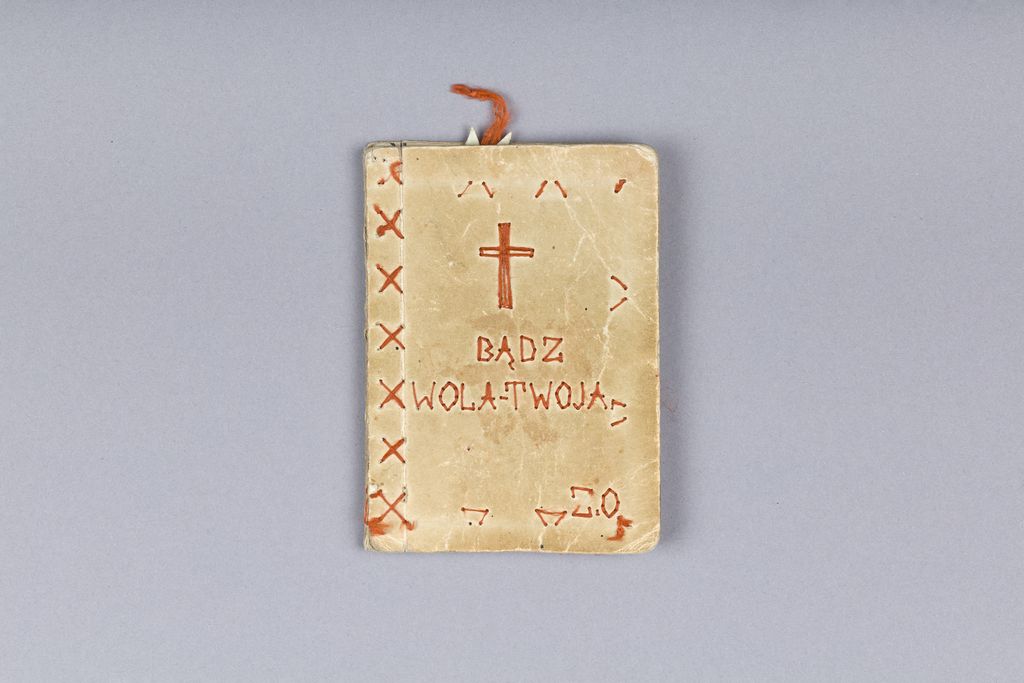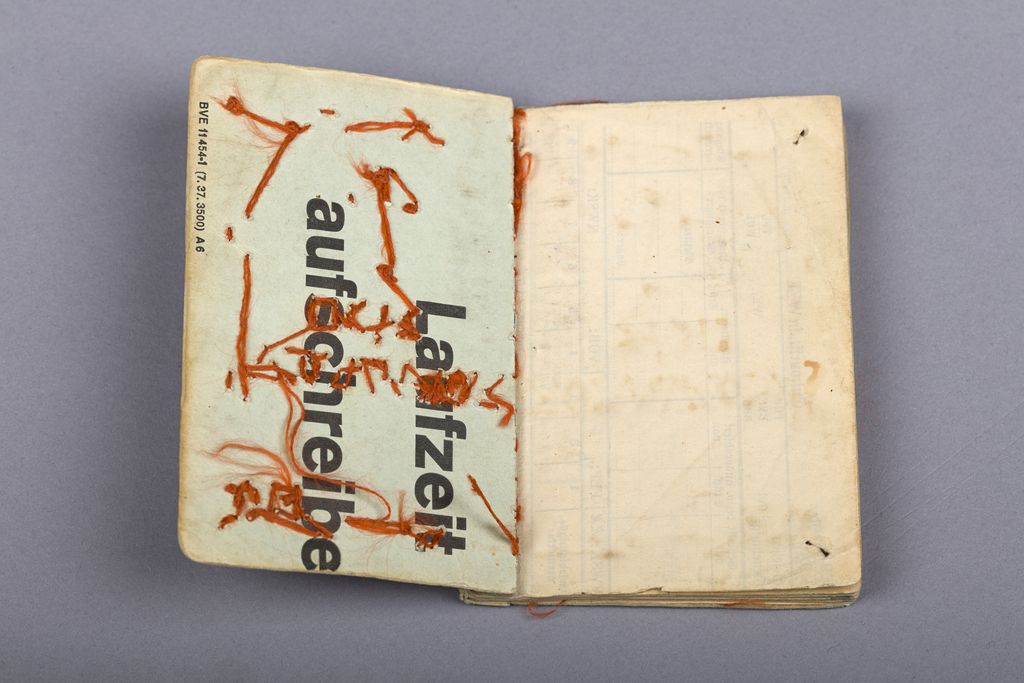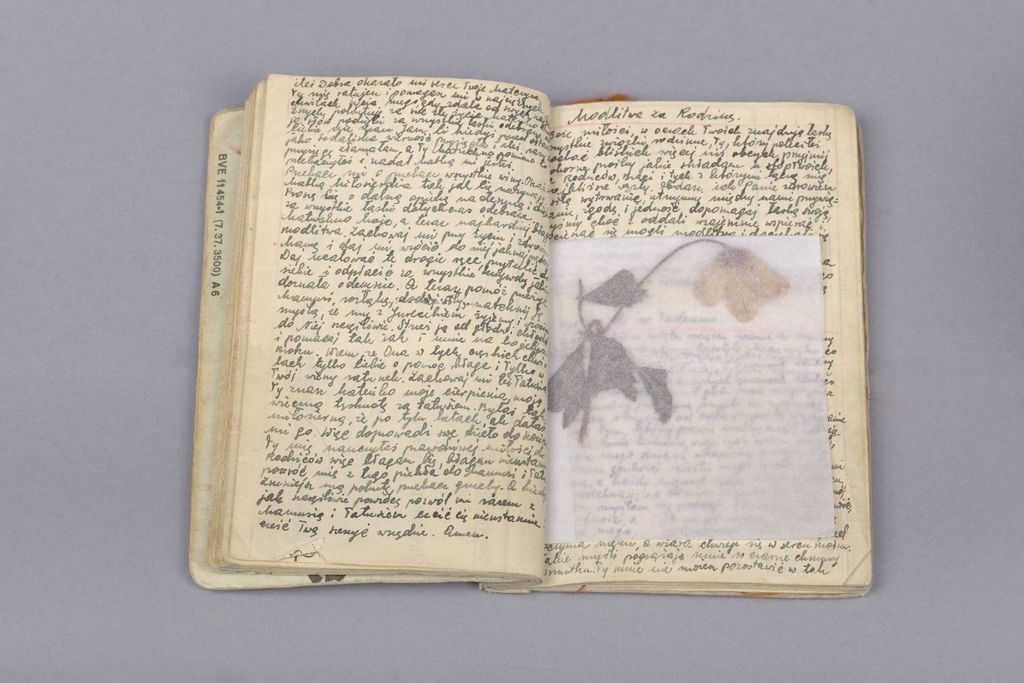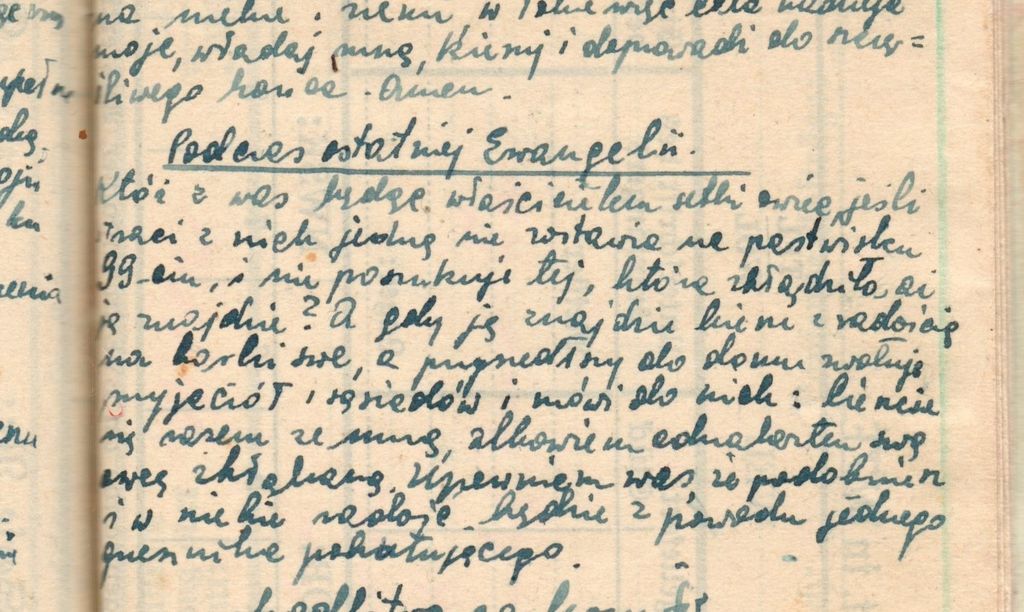Handmade Prayer Book
This small, 10.6 x 7.6 cm booklet is a handmade prayer book. Zofia Sukow, married Czaplicka, made it during her imprisonment in the satellite camp of Dreilinden Maschinenbau GmbH, a subsidiary of Robert Bosch GmbH. The company manufactured accessories for aeroplane engines.
In August 1944, Zofia Sukow, born 1924, was one of around 60,000 Poles who were arbitrarily arrested after the suppression of the Warsaw Uprising against the German occupiers, deported to concentration camps and forced to perform forced labour. After a short stay in the Ravensbrück women's concentration camp, she was sent to the subcamp of the Sachsenhausen concentration camp in Kleinmachnow on 12 September 1944.
The 765 women prisoners had to work 12-hour laundry shifts. They were housed in windowless, damp and unheated rooms in an air-raid shelter below their workshop.
Sukow used 18 DIN A5-sized company forms for the production of the prayer book, which she joined together with white thread.The front is decorated with cross stitches, a cross and bears the title “Badz Wola – Twoja” [Thy will be done], a line from the Lord’s Prayer. She has handwritten 44 Catholic prayers and litanies on 24 pages.
Practising her Catholic faith played a major role for Zofia Sukow, as it did within the Polish prisoner group as a whole. Although not strictly forbidden, this had to take place in secret. A fellow prisoner recalled that a prayer was said in her parlour every evening.
Production in the factory was stopped in mid-April 1945. Approximately 400 women prisoners were taken to Oranienburg via Berlin-Wannsee on a special train. From here, they had to take part in the so-called death march northwards a few days later.
An entry in the prayer book marks this section. On page 27, Zofia Sukow notes the beginning of the evacuation. A dried and pressed bellflower, which she picked during the first break on the death march, is still in the booklet today.
Zofia Sukow survived the death march and returned to Warsaw.
Prayer book of Zofia Czaplicka, née Sukow, 1944-45, Sachsenhausen Memorial Collection, inventory no. 95.00106.2, photos: Cordia Schlegelmilch
Dieses kleine, 10,6 x 7,6 cm große Büchlein ist ein handgefertigtes Gebetbuch. Zofia Sukow, verheiratete Czaplicka, fertigte es während ihrer KZ-Haft im Außenlager der Dreilinden Maschinenbau GmbH, einem Tochterunternehmen der Robert Bosch GmbH in Kleinmachnow. Die Firma stellte Zubehörteile für Flugzeugmotoren her.
Zofia, damals Sukow, Jg. 1924, gehörte im August 1944 zu den rund 60.000 Polinnen und Polen, die nach der Niederschlagung des Warschauer Aufstandes gegen die deutschen Besatzer willkürlich verhaftet, in Konzentrationslager verschleppt und zur Zwangsarbeit gezwungen wurden. Nach kurzem Aufenthalt im Frauenkonzentrationslager Ravensbrück kam sie am 12. September 1944 in das dem KZ Sachsenhausen unterstellte Außenlager in Kleinmachnow.
Die insgesamt rund 765 Häftlingsfrauen mussten in 12-Stunden-Wechselschichten arbeiten. Untergebracht waren sie in fensterlosen, feuchten und unbeheizten Stuben in einem Luftschutzkeller unterhalb ihrer Werkhalle.
Sukow verwendete für die Herstellung des Gebetbuchs 18 DIN A5 große Betriebsformulare der Dreilinden Maschinenbau GmbH, die sie mit weißem Garn zusammenfügte. Die Vorderseite ist verziert mit Kreuzstichen, einem Kreuz und trägt den Titel „Badz Wola – Twoja“ [Dein Wille geschehe], einer Zeile aus dem Vaterunser. Auf 24 Seiten hat sie 44 katholische Gebete und Litaneien handschriftlich geschrieben.
Die Ausübung ihres katholischen Glaubens spielte für Zofia Sukow, wie insgesamt innerhalb der polnischen Häftlingsgruppen, eine große Rolle. Obwohl nicht grundsätzlich verboten, musste dies heimlich stattfinden. Eine Mitgefangene erinnerte sich, dass in ihrer Stube jeden Abend ein Gebet gesprochen wurde.
Die Produktion in der Fabrik wurde Mitte April 1945 eingestellt. Die rund 400 Häftlingsfrauen wurden mit einem Sonderzug über Berlin-Wannsee nach Oranienburg verbracht. Von hier aus mussten sie wenige Tage später am sogenannten Todesmarsch Richtung Norden teilnehmen.
Ein Eintrag im Gebetbuch markiert diesen Abschnitt. Auf Seite 27 notiert Zofia Sukow den Beginn der Evakuierung. Eine getrocknete und gepresste Glockenblume, die sie in der ersten Pause auf dem Todesmarsch gepflückt hat, liegt noch heute in dem Büchlein.
Zofia Sukow überlebte den Todesmarsch und kehrte nach Warschau zurück.
Ein Faksimile dieses Exponats wird in der Dauerausstellung "Das Konzentrationslager Sachsenhausen 1936-1945. Ereignisse und Entwicklungen" in der ehemaligen Häftlingsküche gezeigt.
Gebetbuch von Zofia Czaplicka, geb. Sukow, 1944-45, Gedenkstätte und Museum Sachsenhausen, Inv.-Nr. 95.00106.2, Fotos: Cordia Schlegelmilch, Berlin.





